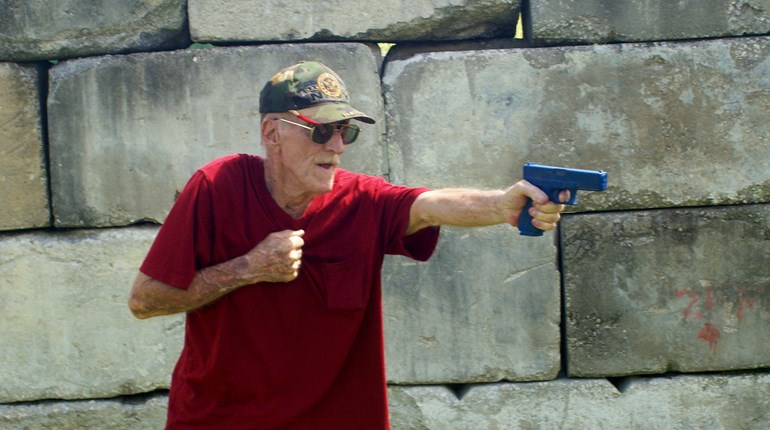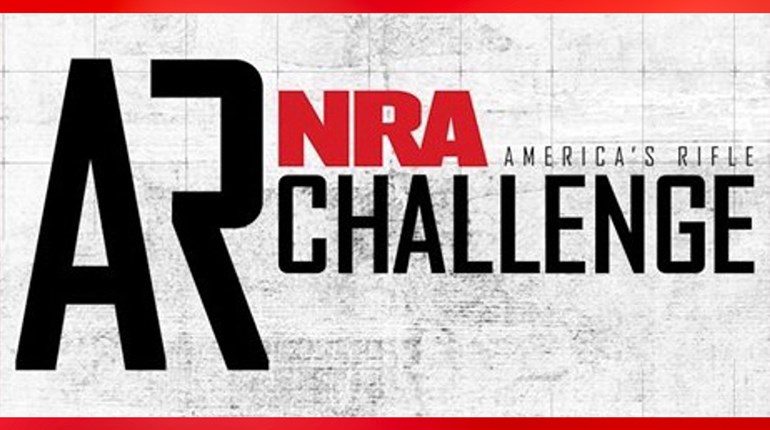
We think Carry Lifers should take a look at Patrick Blanchfield’s “They’re Coming for the Ones You Love” over at the Nation. While we ran a couple of highlighters dry marking the not-so-subtle mockery, eye-rollers and inevitable “outlier” quotes, his treatment of self-defense considerations and training is useful—if not exactly important—in several ways.
In fairness, an initial prop is due: It is candid, albeit from a subtle “anti” perspective. Our public discourse on Second Amendment issues, and specifically concealed carry, is in desperate need of such candor, especially as a pivotal election approaches. In light of this sort of blarney, however, it’s constructive to know what trivia distracts the eye and draws the scorn of those who think meaningful self-defense ought to be the exclusive province of well-intentioned—if preponderantly unavailable—professional civil servants, rather than a natural right of considerable vintage and an obvious, essential prerogative for any individuals aspiring to substantive autonomy.
A reprise is useful. Following a nerve-jarring incident in the middle of the night, Blanchfield (wisely, in our view) accepted his self-described “panic” as a dawning recognition that his defensive reactions were a reflection of “unconscious incompetence.” Through slightly complex machinations, his eventual next step was a trip to the behemoth Front Sight Firearms Training Institute in Pahrump, Nev., Theoretically, at least, it would be a good story for a “freelance writer and academic,” and those reactions could be molded into something more like confidence and clear thinking in a defensive situation. Prop number two—a good plan.
Forty-one hundred words later, and in light of our own recent sojourn at Gunsite Academy (here, here and here), we reiterate: At least it is candid, and of course Blanchfield is entitled to any of his opinions (based on another of those amendment thingies, if memory serves). But with that said, there are ample bones, as the aphorism goes, to pick. In no particular order:All [the Cooper Codes] really say is “pay some damned attention and have a plan, nitwit—and you and those you care about will be a lot better off.”
Is there really some problem with the “obligations and responsibilities” of Col. Jeff Cooper’s Color Codes?
Detailed here, all these really say is “pay some damned attention and have a plan, nitwit—and you and those you care about will be a lot better off.” It implies nothing, per se, about armed defense, and conditions Yellow and Orange are in fact the best way to avoid the need for any sort of confrontation. But, pretending that Red will never happen—and thus being helpless when it does—is willful ignorance, as more than 1.16 million violent crime victims or their surviving family members (most recent FBI UCR here) can gruesomely attest.
The actual strength and purpose of Col. Cooper’s Codes is emphatically not to make you paranoid or trigger-happy, but rather as a logical “razor”: By being mentally prepared at all times, you are far less likely to make a physical error with your firearm or any other wherewithal, and therefore to survive, all without lethal implications for anyone. Also, not coincidentally, this is why virtually all armed services and police forces have adopted the Codes since Cooper elucidated them in the 1970s: They reduce violence, not foment it.
Moreover, could we please stop the idiotic baseball bat metaphors and suggestions? Have you ever tried this in your own house? A hallway? A doorway? Carried everywhere you go? At age 75? To say nothing of the fact that this would be illegal under many circumstances.
What is it, precisely, that worries you about the 14.5 million CCW permits/carriers, however granted or licensed?
It’s true that there is wide variation in state-based requirements for concealed carry, and even that some greater consistency between those standards might—arguably—be a good thing. But between near-constant, condescending assertions of gross civilian incompetence, including this missive that had to be partially retracted from The Nation’s own pages, isn’t more and better training (à la Front Sight and similar organizations) automatically preferable to less, and particularly to none at all?
Note that the same demographic, however gently impugned or variously permitted, remains six- to 10-times more law abiding than law enforcement, and therefore 180- to 300-times more law-abiding than the average citizen. Yeah: 180- to 300-times, not just percent. We did the math.
So the NRA should not train millions of Americans in firearms safety?
Curious, again: In a world where supposed adults are obsessed with Pokémon Go, how is helping young people feel accountable and mature a bad thing?In the same vein is the licensing snipe. There’s an attempt to create, or at least besmirch, any link between the NRA’s legislative, instructor-certification and training programs: “… funneling applicants … to 125,000 instructors and (teaching) 1 million students.” Again: In what way, precisely, is more training bad—especially when such training incudes basic gun safety and shooting and concealed carry instruction; non-shooting safety training for very young children; and high-level instruction for law-enforcement officers and agencies? The problem here would beeeeeee … well, nothing, we suggest.
And “funneling?” Suffice it to say we’ve been NRA-certified in multiple disciplines for years, and don’t know of a single student who has reached us through the suggested, excoriated vector.
How are veiled cheap shots at attendees advancing any part of this discussion?
One word here: “Cayden” (read the piece, and you’ll see what we mean). Pick on the 17-year-old … so classy. By-the-by, in a 25-year firearms training career, we’ve instructed many youngsters, and the single greatest commonality is the observation by the occasional disconsolate teen—as well as his or her parents—of how much they valued the trust implicit in their instruction, and how clearly they understood the huge responsibilities they’d been entrusted with. In a world where supposed adults are obsessed with Pokemon Go, how is helping young people feel accountable and mature a bad thing?
OK, so Front Sight’s marketing is, er, cheesy.
This is very different from trying to build urgency and emotional scale, if you will, into training that has inherently unpleasant aspects. We wouldn’t have written Blanchfield’s fiancee’s name on the hostage in a target array, but how else do you propose to elevate, or at least instill, seriousness for adult learners? Deride it as a “scripted, psychologically engineered ‘come to Jesus’ moment,” if you like, but often-cynical adult learners have decades of media blather about personal safety to unlearn. We feel particularly qualified to comment here: In another life, we did instructional design and delivery for several decades in the Fortune 100 environment, and getting adult students to commit to critical learning in any context (to say nothing of theoretical life-and-death) is far from trivial. Mental pathways can run very deep indeed, whether work- or survival-oriented, and rerouting them is at least a chore. Just sayin’.Stop the mocking implication that fearmongering, vague sociopathy and marketing are what motivate the rest of us. If not the Bill of Rights, then certainly an incredibly law-abiding track record should have earned us the right to decide for—and defend—ourselves.
A second point here: While we might share Blanchfield’s opinion of the marketing approach, this ought not (and most wisely would not) be extrapolated to the quality of instruction. Take a look here, for instance. When we need instructional support for our own teaching, two of our most trusted go-tos are multi-course, even “distinguished” Front Sight graduates: Cris and Steve Bonser. They’re not just caring, thoughtful, fabulous people, but pistol shooters and instructors of consequence.
But what really rang our bell …
… was an odd ramble through crime victimization “whys” and “wherefores.” Blanchfield calls an estimated 2.5 million defensive gun uses per year “absurd,” and then invokes an also-widely-disputed estimate of only 70,000 (from vocal, perennial Harvard anti-gunner David Hemenway). How such “absurdity” was determined remains an obvious question, even when murkily explained by Hemenway. Professors John Lott and Gary Kleck defend vastly more, yet even they don’t agree. The point remains the same: Defaulting to the lowest number out there—by a factor of up to 36 times—is particularly wide of the mark. Remember, we had reported violent crimes of well over 1.1 million in 2014, yet absolutely no way to know how many malefactors simply turned around when they heard a slide or bolt slam home in the dark where they didn’t belong, or faced resolute eye contact and a staged draw.
We’d argue, however, that the worst is Blanchfield’s glib “… but household members were the victims of direct physical violence only 7 percent of the time.” Catch it? That’s a minimum of 57,000-plus actual attacks dismissed as though they were happening to office plants, rather than generating life-changing—or eventually life-ending—consequences like these.
We leave it to Blanchfield to defend this diminution of the suffering of the unwashed, or at least of the undefended. We sincerely hope it isn’t motivated by callous, celebritista, it-sucks-to-be-you elitism based on a mere four days in the Nevada desert. After all, 100 million Americans exercise their Second Amendment rights in remarkable safety day in and day out with no nannyist aid. The bad gun news comes in vast disproportion from a much tinier sliver of America that no one could truthfully describe as remotely “functional.” So provisional props for that, too.
If by chance, however, he remains willing only to plead for the safety of his newly minted family from the demonstrably unmerciful, then his risk assessments and all their consequences should remain his own as well. Not by another's action—or vote—should such an opinion be insinuated into public policy, especially when such a policy threatens only the most law-abiding of Americans, while not impeding very real predation in the slightest.
Stop the mocking implication that fear-mongering, vague sociopathy and marketing are what motivate the rest of us. If not the Bill of Rights, then certainly an incredibly law-abiding track record should have earned us the right to decide for—and defend—ourselves.
Now Carry on.

































